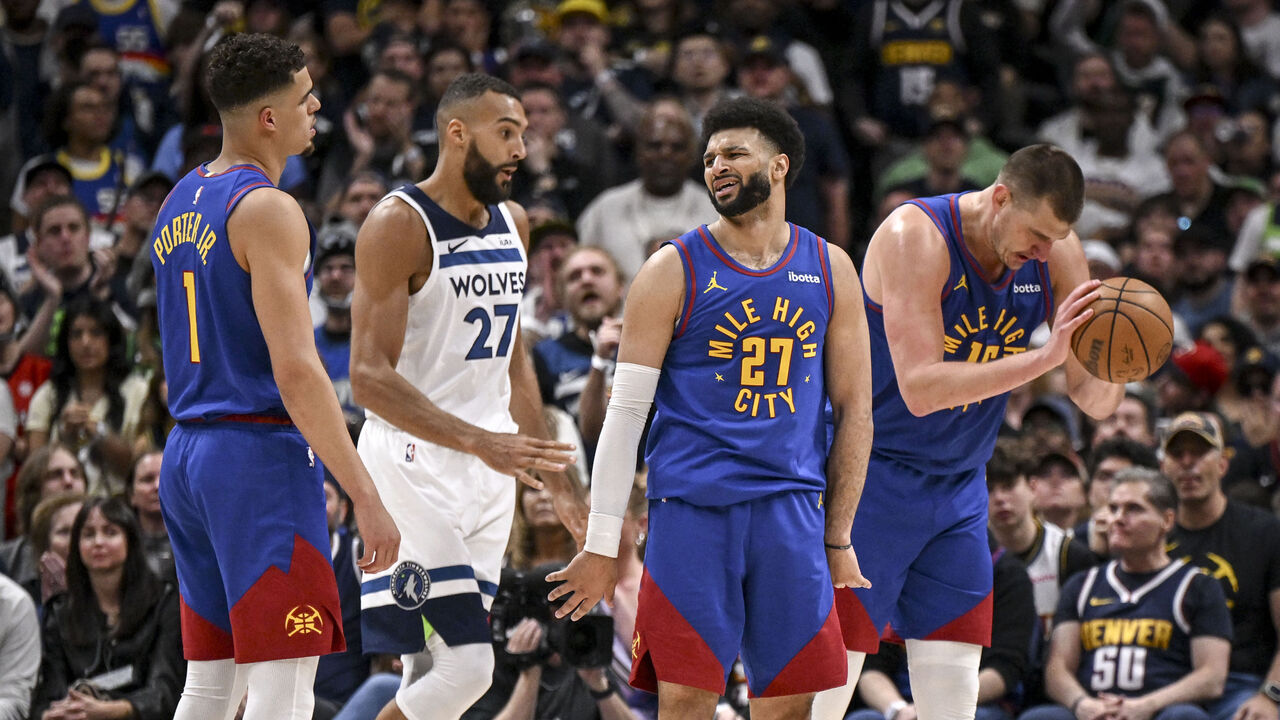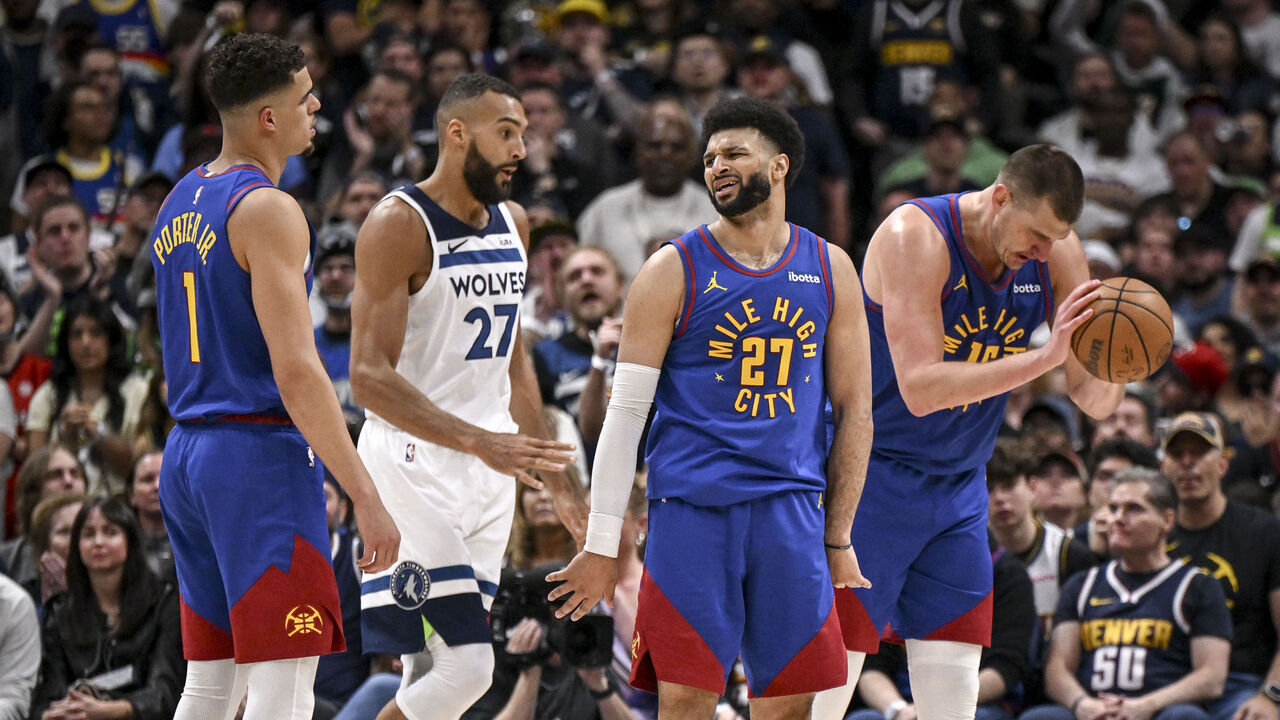How the T-Wolves put clamps on the Jokic-Murray combo
There’s a reason the Denver Nuggets didn’t get very far in the two postseasons Jamal Murray missed with a torn ACL, but romped to the title and followed that up with a 57-win campaign after Murray returned. Defending Nikola Jokic is a head-splitting puzzle on his own, given the way he can obliterate single coverage and double-teams in almost equal measure. But melding his interior scoring and playmaking genius with Murray’s supreme shot-making, ball-handling, and off-ball jukery takes that challenge to another level.
For the better part of the last 18 months, the deadliest two-man game in the NBA has left opposing defenses scratching their heads. Some teams found temporary success by junking things up with a variety of tactics, but none landed on anything resembling a consistent answer for how to defend Jokic and Murray in tandem. Until now.
The Minnesota Timberwolves have the defending champs on the ropes in the West semis, taking a 2-0 series lead back home. And while there are a host of reasons for their dominance, the biggest is that for at least two games, they solved the purportedly unsolvable equation at the heart of Denver’s high-powered offense. They even did so without the services of newly minted four-time Defensive Player of the Year Rudy Gobert in Monday’s Game 2.
Minnesota’s league-best defense has held the Nuggets to a comical 97.8 points per 100 possessions, 20 fewer than they averaged in the regular season. And Jokic-Murray actions (i.e. pick-and-rolls or dribble-handoffs, with either of them screening) have produced just 0.94 points per possession after generating 1.12 during the season, according to a source with Second Spectrum access.
The obvious caveat is that Murray isn’t operating anywhere near 100%, battling a calf injury that’s seemingly sapped his explosiveness and probably impacted his jump shot. But it would be foolish to ignore the role the Timberwolves have played in holding him and Jokic to a combined 25-for-70 (36%) shooting with 16 turnovers through two games.

In Game 1, the Wolves predictably went with their cross-matching strategy of making Karl-Anthony Towns (and at other times Naz Reid) the primary defender on Jokic, and letting Gobert be a roving helper nominally guarding Aaron Gordon. With the non-shooting Gordon spending most possessions camping in the dunker spot or the corner, Gobert was free to patrol the back line. Among other things, that allowed Towns and Reid to stay attached to Jokic when he set ball screens for Murray, which took away a lot of Jokic’s short-roll opportunities.
That coverage isn’t novel; the Celtics notably used it to combat the James Harden-Joel Embiid pick-and-roll in the playoffs last year, and we saw a bunch of teams (including the Lakers at points in last year’s West finals) subsequently adopt it as a counter against Denver. We’ve just never seen a team execute it as effectively as Minnesota did.
Keeping the screen defender in those actions stapled to Jokic concedes driving lanes to Murray. But the Wolves trusted that the rearview pressure from the various on-ball defenders who toggled through that matchup (Jaden McDaniels, Nickeil Alexander-Walker, and Anthony Edwards), coupled with Gobert’s presence in the paint, would make those lanes treacherous to navigate.
Though Murray missed a handful of floaters and mid-rangers that are (for him) very makeable shots, he never looked entirely comfortable with the length of the defenders sandwiching him while the pocket pass was denied. Even when he did score against that coverage, nothing came easily:
HOW DID JAMAL MURRAY FINISH THIS?! ? pic.twitter.com/0eafqIHN90
— NBA on TNT (@NBAonTNT) May 5, 2024
Simply put, the Wolves would rather have Murray make the decisions in those two-on-one scenarios than Jokic. Murray isn’t a bad playmaker by any means, but he doesn’t have Jokic’s vision or manipulative creativity (because nobody does), nor does he have Jokic’s short mid-range touch (because nobody does).
Even when Murray was able to make the pocket pass and give Jokic those short rolls, the Wolves handled them about as well as possible. Jokic still hit a few of his patented push shots and found Gordon with a couple of lobs, but Gobert generally did a terrific job playing in between them, declining to commit in one direction or another until the last second. On a crucial late-game possession, Murray got two on the ball out of a DHO and hit Jokic on the roll. Gobert lunged out at him, but he kept his weight on his back foot, so when Jokic took the bait and threw the lob, Gobert was able to retreat and break it up.
Consistently putting their best defensive rebounder in position to have to play the ball could’ve hurt the T-Wolves on their own glass. But thanks to Gobert’s recovery instincts, and the alertness with which the team’s weak-side defenders sank down to cover Gordon whenever Gobert stepped up, Minnesota conceded just three second-chance possessions to one of the best offensive rebounding teams in the league.
In Game 2, with Gobert back in Minneapolis attending to the birth of his daughter, the Wolves had to adjust. They kept Towns on Jokic, but without Gobert’s back-line help, they didn’t feel quite as comfortable ceding the middle of the floor to Murray. They still did on some occasions, especially when they shifted McDaniels onto Gordon and could count on him to serve as the last line of defense.
More often, though, they had Jokic’s defender show help on Murray coming off screens and engaged a third defender on the back side of those actions. They dialed up the aggression and sprung more double- and triple- teams on both guys. The result, incredibly, was an even more dominant defensive showing, one in which they turned the Nuggets over 19 times and held them to their lowest single-game offensive rating (87.9) since January 2018. This, despite the fact that Denver snared 18 offensive boards in the contest.
Part of the reason the shift in tactics worked so well is that after having the short roll denied in Game 1, and facing unyielding pressure, Murray was looking to get off the ball quickly and find the pocket the Timberwolves occasionally conceded in Game 2. That led him to force passes that the defense was sneakily waiting for, or fail to anticipate Minnesota’s more aggressive nail help and kill his dribble before spotting the release valve.
The Wolves also switched basically every off-ball action that didn’t involve Towns or Mike Conley. And the physicality of their switches prevented the Nuggets from accessing their usual array of slips and backdoor cuts, or from getting the kind of separation they’re accustomed to on pet plays like Rip DHOs for Murray.
More than any team in the NBA, the Nuggets rely on cuts to get to the rim. They ranked fourth in rim frequency during the regular season despite ranking last in drives. But their rate of cuts stemming from off-ball actions has fallen from about 56 per 100 possessions during the regular season to under 48 in this series, and their scoring average on those possessions has tanked from 1.04 to 0.89, per a source with Second Spectrum access. The Wolves are jamming up those cuts and in the process exposing Denver’s limitations as a dribble-drive team, especially with Murray hobbled. The Nuggets shot just 34% on drives in Games 1 and 2, with Murray going 4-for-17, per NBA Advanced Stats.
This series isn’t over, even if it feels that way. Denver will almost certainly shoot better than it has so far. This is one of the best mid-range scoring teams in the league, ranking third during the regular season at 47% on all non-rim 2-pointers. In this series so far, they’re shooting 28% on those in-between shots – hitting 30% from floater range and 23% from long mid-range, per Cleaning the Glass. The Timberwolves’ length makes them particularly good at challenging shots in that zone, but suppressing Denver’s proficiency to this extent is not sustainable. Jokic will find his touch. With three days off before Game 3, perhaps Murray will improve physically and find his, too.
The Nuggets could also probably stand to incorporate more inverted ball screens for Jokic, especially those that bring Conley into the action. They could work harder to get Conley switched onto Murray and then run their two-man game from there. (Murray has set just two ball screens for Jokic through two games.) They could also make better use of Gordon as a pin-in screener to punish Minnesota for ignoring him in the dunker spot. There are a ton of things they can do better.
But the DPOY is about to re-enter the fray, and things aren’t going to get any easier. This is a challenge unlike any the Nuggets have faced over their last two playoff runs. Time to see what they’re made of.


